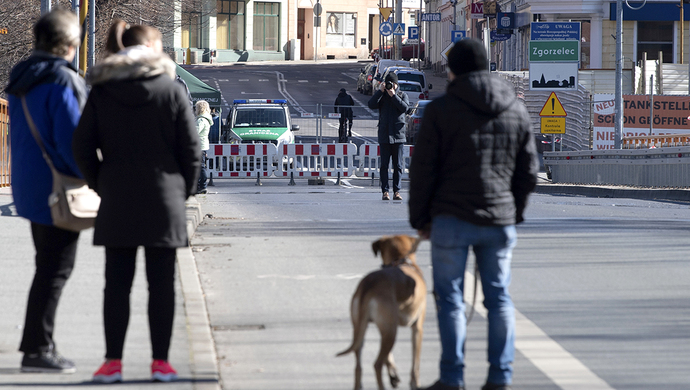
针对当前备受国际关注的欧洲抗击新冠肺炎疫情进展以及不同国家采取的防疫策略,世界卫生组织欧洲区域办事处高威胁性病原体团队负责人理查德·皮博迪博士(Dr. Richard Pebody)当地时间16日独家接受中新社国是直通车记者专访表示,不存在一种适合所有国家的防疫模式,每个国家应该做的是实施最适合其自身情况的措施。针对德国较低的病死率,他特别提醒,除意大利外的其它欧洲国家疫情发展还处在较为早期的阶段。“这部分国家也许会在接下来数日或数周经历死亡病例增多。”
世卫组织总干事谭德塞本月13日指出,欧洲现在已经成为大流行疫情的中心,报告的病例和死亡人数超过了除中国以外世界其他地区的总和。世卫组织欧洲区域办事处截至欧洲中部时间16日23时的数据显示,欧洲国家累计确诊人数已达63268人,死亡2755人。
位于丹麦哥本哈根的世卫组织欧洲区域办事处负责欧洲地区50个国家。皮博迪当天远程接受了中新社国是直通车记者专访。
皮博迪核心观点如下:
防疫不存在“适合所有脚的鞋子”,各国只能因地制宜
德国病死率低可能因其疫情处在早期,需要密切关注接下来数日到数周发展
当前急需各国加大响应力度、检测力度、减缓传播的力度
每个人做出自己的贡献同样重要
谈中国派专家组赴意大利:事实证据和已经取得的经验教训将帮助我们战胜这场大流行病和未来的大流行病
采访实录(中英文对照)如下:
国是直通车:世卫组织日前宣布将新冠肺炎疫情定性为大流行,这一定性是否会对欧盟及其成员国对新冠肺炎暴发的应对产生影响?
答:将新冠肺炎COVID-19疫情定性为“大流行”并未改变世卫组织给各国和个体的相关建议。这一定性提供的只是一种程度更强的提醒,敦促各方采取必须采取的行动。
国是直通车:在2月26日于罗马举行的世卫、欧盟和意大利三方会议期间,欧盟委员会卫生与食品安全事务委员斯泰拉·基里亚基季斯曾表示“我们已要求欧盟成员国重新评估其应对大流行病的预案以及从诊断、化验到追踪接触者在内的整体医疗能力,并将评估情况和实施计划上报欧盟”。从世卫组织的角度来看,欧盟成员国目前更新它们各自的大流行病预案的情况如何?
答:世卫组织持续地与所有国家保持合作,帮助它们维持和提示各自的国家大流行病预案。
世卫组织欧洲区域办事处派出的技术团队已被部署至意大利、阿塞拜疆、乌克兰、黑山和亚美尼亚等国。我们正持续以远程或现场的方式为它们提供着有针对性的协助,具体采取何种形式取决于目前条件下的旅行通达性。世卫组织已编制了内容丰富、涉及防疫工作所有领域的技术指南。我们正在支持每一个国家制定防疫技术方案,并在一个强有力的全国性策略框架下落实最迫切的行动内容。
世卫组织欧洲区域办事处同时也在响应新冠肺炎(COVID-19)疫情的各个层面与欧盟和欧盟疾控中心(ECDC)开展着紧密的合作。
国是直通车:世卫组织在欧盟国家应对疫情方面有无推荐的“最佳实践”或者最佳模式?还是说每个国家都不一样?
答:不存在一种“适合所有脚的鞋子”式的模式。每个国家的卫生体系都不相同,它们的人口结构也各不相同——因此,每个国家是根据它们的本国情况以及疫情在它们的国家和地区所处的阶段去决定采取何种行动。每个国家应该做的是,实施最适合其自身情况的措施,这些措施是与当地情况相结合的。
国是直通车:德国的新冠肺炎死亡率与意大利比起来相当的低。甚至与法国和西班牙相比,德国也是非常低的。您如何解读这一差异?这是反映欧盟各国公共卫生应急能力的落差,还是说由于上面提到的防疫模式之别所致?(注:德国疾病防控机构罗伯特·科赫研究所数据显示,截至当地时间3月16日15时,德国共确诊6012例新冠病毒肺炎感染病例,其中死亡病例13例。据此计算,死亡率为0.2%。而意大利的死亡率达到7.3%,全球平均死亡率为3.7%。)
答:为了战胜这种新型病毒,现在急需各国加大对病毒威胁的响应力度,加大检测力度,也加大减缓病毒传播的力度,以拯救人们的性命。在当前的阶段,每个个体也参与到这一抗击疫情的努力中,作出自己的贡献也非常关键。特别是,我们鼓励公众遵循所在国家的卫生部门的指南,并且为他人提供帮助。
世卫组织同时提醒人们要警惕对流行病学数据的解读,这其中包括不同国家之间的病死率(case fatality rate)差异。具体到COVID-19新冠肺炎,那些因为感染这种病而去世的病人平均是在两到三周前被感染的。意大利的疫情暴发和发展要比欧洲其它地方开始得更早,因此出现了更多的病人来到上述的关键周期,这时他们要么治愈出院,要么不幸离世。其它欧洲国家疫情发展所处的还是一个早期阶段。这部分国家也许会在接下来数日或数周经历死亡病例增多。
同时,病死率也可能受到病例年龄分布影响——70岁以上的感染者死亡率最高。在大流行病的早期阶段,出现有更多处于工作年龄的成年人被感染也是可能的。这是因为大流行病还没有从他们身上传播到老年人群,后者的病死率更高。
最后,对疑似病例检测的覆盖程度也将影响病死率数字。不同国家的检测体系决定了它们发现确诊病例的能力不尽相同。如果不是所有感染者都被发现并确诊(特别是排除了轻症患者)的话,这就会影响到病死率。
国是直通车:中国已向意大利派出一队抗疫医疗专家组,帮助当地抗击疫情。欧洲是否能够、或者应该从中国抗疫中学习任何经验?如果有的话是什么?
答:这是一种新的病毒,且形势正在快速演变发展。世卫组织专家和其它各方都正在争分夺秒地搜集、整理和传播针对这种病毒的研究成果和抗击疫情前线的信息,这是为了让我们对这种病毒了解得更充分,也持续地改进每个国家作出的响应。事实证据和已经取得的经验教训将帮助我们战胜这场大流行病和未来的大流行病。
Q: Which impact will WHO's announcement have on the EU and its member states fighting against the coronavirus outbreak?
A: Calling COVID-19 a pandemic does not change WHO’s advice to countries and individuals. What it does do is provide a stark reminder for implementing needed actions.
Q: During the last meeting in Rome on 26 February 2020, the EU Commissioner Kyriakides has told that "we have requested Member States to review their pandemic plans as well as health care capacities, including capacity for diagnosing, laboratory testing and procedures for contact tracing. All Member States need to inform us about their preparedness plans and how they propose to implement them"
From WHO's perspective, how well have the EU member states updated their plans so far?
WHO works continually with all countries to maintain and improve their national preparedness plans.
A: WHO/Europe technical missions have also been deployed to Italy, Azerbaijan, Ukraine, Montenegro, Armenia. We are continuing to provide tailored assistance remotely or on-site depending on the possibility of travelling in the current context. WHO has developed an abundance of technical guidance in all areas of work: we are supporting each and every country to develop technical plans and implement priority actions in the framework of a strong nationwide strategy.
WHO/Europe also works closely with the European Union and the European Centre for Disease Control on all aspects of the COVID-19 response.
Q: Does WHO have any recommendation on which model would be the best for most countries in the EU to follow or it just varies from country to country?
A: There is no one-size-fits-all approach. Every health system is different, the demographics are different so each country takes action according to their national context and the stage the outbreak has reached in their area. Every country should decide to implement the most appropriate measures adapted to the local contexts.
Q: The coronavirus death rate in Germany is quite low so far compared to the rate in Italy. And even compared to the death rate in France or Spain, the rate in Germany is still very low. How do you interpret this difference? Does it reflect a gap of public health capabilities among the member states? Or is it because of the difference in approach as mentioned above?
A: To fight this new virus, there is now a great need for countries to scale up response to treat, detect and reduce transmission to save people’s lives. At this stage it is also critical that everybody join the efforts and do their part. In particular, we encourage citizens to follow guidance from health authorities and reach out to support others.
WHO also urges caution in interpreting epidemiological numbers, including differences in the case fatality rates between countries. In the case of COVID-19, patients who pass away from the disease were infected 2-3 weeks previously on average. The outbreak in Italy has been evolving for longer than other places in Europe and therefore more patients will have completed their final outcome and either been discharged or sadly passed away. Other European countries, who are earlier in the epidemic, may well begin to experience deaths in the coming days and weeks. The case fatality rate can also be affected by the age profile of cases; deaths usually occur in the elderly (>70 years).
In the early stages of the epidemic it is possible that more cases occur among working age adults before the epidemic spreads to older populations, where the case fatality is higher. Lastly, the sensitivity of case detection will make a difference, and national surveillance systems may vary in their ability to detect cases. If not all cases, particularly excluding the milder cases, are being detected then this will affect the case fatality ratio.
Q: China has sent an anti-epidemic expert team to Italy to help fight COVID-19. Could or should Europe learn anything from China? If so, what is it?
A: This is a new virus and a rapidly evolving situation. WHO experts and others are working around the clock to collect, compile and disseminate research findings and information from the field, to learn more about the virus and continuously improve each country’s response. Evidence and lessons learned will help us beat this and future pandemics.
 我也说两句
我也说两句
























































